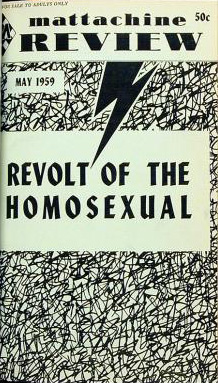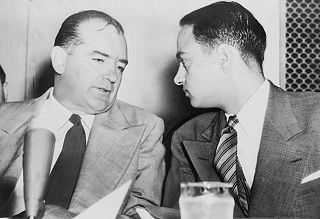| Decades in LGBT rights (table) |
|---|
| 1950s |
This is a list of notable events in the history of LGBT rights that took place worldwide in the 1950s.
| Decades in LGBT rights (table) |
|---|
| 1950s |
This is a list of notable events in the history of LGBT rights that took place worldwide in the 1950s.

Lesbian, gay, bisexual, transgender and queer (LGBTQ) movements are social movements that advocate for LGBTQ people in society. Although there is not a primary or an overarching central organization that represents all LGBTQ people and their interests, numerous LGBTQ rights organizations are active worldwide. The first organization to promote LGBTQ rights was the Scientific-Humanitarian Committee, founded in 1897 in Berlin.

The Mattachine Society, founded in 1950, was an early national gay rights organization in the United States, preceded by several covert and open organizations, such as Chicago's Society for Human Rights. Communist and labor activist Harry Hay formed the group with a collection of male friends in Los Angeles to protect and improve the rights of gay men. Branches formed in other cities, and by 1961 the Society had splintered into regional groups.
This is a list of notable events in the history of LGBT rights that took place in the 20th century before 1949.

The White Night riots were a series of violent events sparked by an announcement of a lenient sentencing of Dan White for the assassinations of George Moscone, the mayor of San Francisco, and of Harvey Milk, a member of the city's Board of Supervisors who was one of the first openly gay elected officials in the United States. The events took place on the night of May 21, 1979, in San Francisco. Earlier that day White had been convicted of voluntary manslaughter, the lightest possible conviction for his actions. The lesser conviction outraged the city's gay community, setting off the most violent reaction by gay Americans since the 1969 Stonewall riots in New York City.

The Lavender Scare was a moral panic about homosexual people in the United States government which led to their mass dismissal from government service during the mid-20th century. It contributed to and paralleled the anti-communist campaign which is known as McCarthyism and the Second Red Scare. Gay men and lesbians were said to be national security risks and communist sympathizers, which led to the call to remove them from state employment. It was thought that due to the stigma around homosexuality, gay people were vulnerable to blackmail, which could lead to a breach in national security. Lesbians were at less risk of persecution than gay men, but some lesbians were interrogated or lost their jobs.
The Society for Human Rights was an American gay-rights organization established in Chicago in 1924. Society founder Henry Gerber was inspired to create it by the work of German doctor Magnus Hirschfeld and the Scientific-Humanitarian Committee and by the organisation Bund für Menschenrecht by Friedrich Radszuweit and Karl Schulz in Berlin. It was the first recognized gay rights organization in the United States, having received a charter from the state of Illinois, and produced the first American publication for homosexuals, Friendship and Freedom. A few months after being chartered, the group ceased to exist in the wake of the arrest of several of the Society's members. Despite its short existence and small size, the Society has been recognized as a precursor to the modern gay liberation movement.

The Black Cat Bar or Black Cat Café was a bar in San Francisco, California. It originally opened in 1906 and closed in 1921. The Black Cat re-opened in 1933 and operated for another 30 years. During its second run of operation, it was a hangout for Beats and bohemians but over time began attracting more and more of a gay clientele, and becoming a flashpoint for what was then known as the homophile movement, a precursor to the gay liberation movement that gained momentum in the 1960s.
This is a list of notable events in the history of LGBT rights that took place in the 1960s.

LGBTQ movements in the United States comprise an interwoven history of lesbian, gay, bisexual, transgender and queer social movements in the United States of America, beginning in the early 20th century. A commonly stated goal among these movements is social equality for LGBTQ people. Some have also focused on building LGBTQ communities or worked towards liberation for the broader society from biphobia, homophobia, and transphobia. LGBTQ movements organized today are made up of a wide range of political activism and cultural activity, including lobbying, street marches, social groups, media, art, and research. Sociologist Mary Bernstein writes:
For the lesbian and gay movement, then, cultural goals include challenging dominant constructions of masculinity and femininity, homophobia, and the primacy of the gendered heterosexual nuclear family (heteronormativity). Political goals include changing laws and policies in order to gain new rights, benefits, and protections from harm.
LGBTQ rights organizations are non-governmental civil rights, health, and community organizations that promote the civil and human rights and health of sexual minorities, and to improve the LGBTQ community.

The Boise homosexuality scandal refers to a sweeping investigation of a supposed "homosexual underground" in Boise, Idaho that started in 1955. Beginning with the arrest of three men in October 1955, the investigation broadened to encompass allegations that more than 100 young men and teenage boys had been involved in sexual acts with a ring of adult homosexual men. By the time the investigation wound down in January 1957, some 1,500 people had been questioned, sixteen men faced charges, and fifteen of them were sentenced to terms ranging from probation to life in prison.
The Janus Society was an early homophile organization founded in 1962 and based in Philadelphia. It is notable as the publisher of Drum magazine, one of the earliest gay publications in the United States and the one most widely circulated in the 1960s, and for its role in organizing many of the nation's earliest LGBT rights demonstrations. The Janus Society takes its name from the Roman two-faced God Janus of beginnings, endings, and doorways. The organization focused on a policy of militant respectability, a strategy demanding respect by showing the public gay individuals conforming to hetero-normative standards of dress at protests.
President Dwight D. Eisenhower issued Executive Order 10450 on April 27, 1953. Effective May 27, 1953, it revoked President Truman's Executive Order 9835 of 1947, and dismantled its Loyalty Review Board program. Instead, it charged the heads of federal agencies and the Civil Service Commission, supported by the Federal Bureau of Investigation (FBI), with the task of investigating federal employees to determine whether they posed security risks. It expanded the definitions and conditions used to make such determinations. The order contributed to the ongoing Lavender scare of the mid-1950s, barring thousands of lesbian and gay applicants from government jobs.

In the United States, lesbian, gay, bisexual, transgender and queer (LGBTQ) people have a long history, including vibrant subcultures and advocacy battles for social and religious acceptance and legal rights.
James "John" Finley Gruber was an American teacher and early LGBT rights activist.

LGBTQ history in the United States consists of the contributions and struggles of lesbian, gay, bisexual, transgender and queer (LGBTQ) people, as well as the LGBTQ social movements they have built.

This article addresses the history of gay men in the United States. Unless otherwise noted, the members of same-sex male couples discussed here are not known to be gay, but they are mentioned as part of discussing the practice of male homosexuality—that is, same-sex male sexual and romantic behavior.

The following is a timeline of lesbian, gay, bisexual, and transgender (LGBT) history in the 20th century.
The Mattachine Society of Washington (MSW) was a gay rights organisation founded in August 1961 by Frank Kameny and Jack Nichols. While the organisation was named after the original, California-based Mattachine Society established in 1950, it was distinguished from other Mattachine Societies by its militancy.